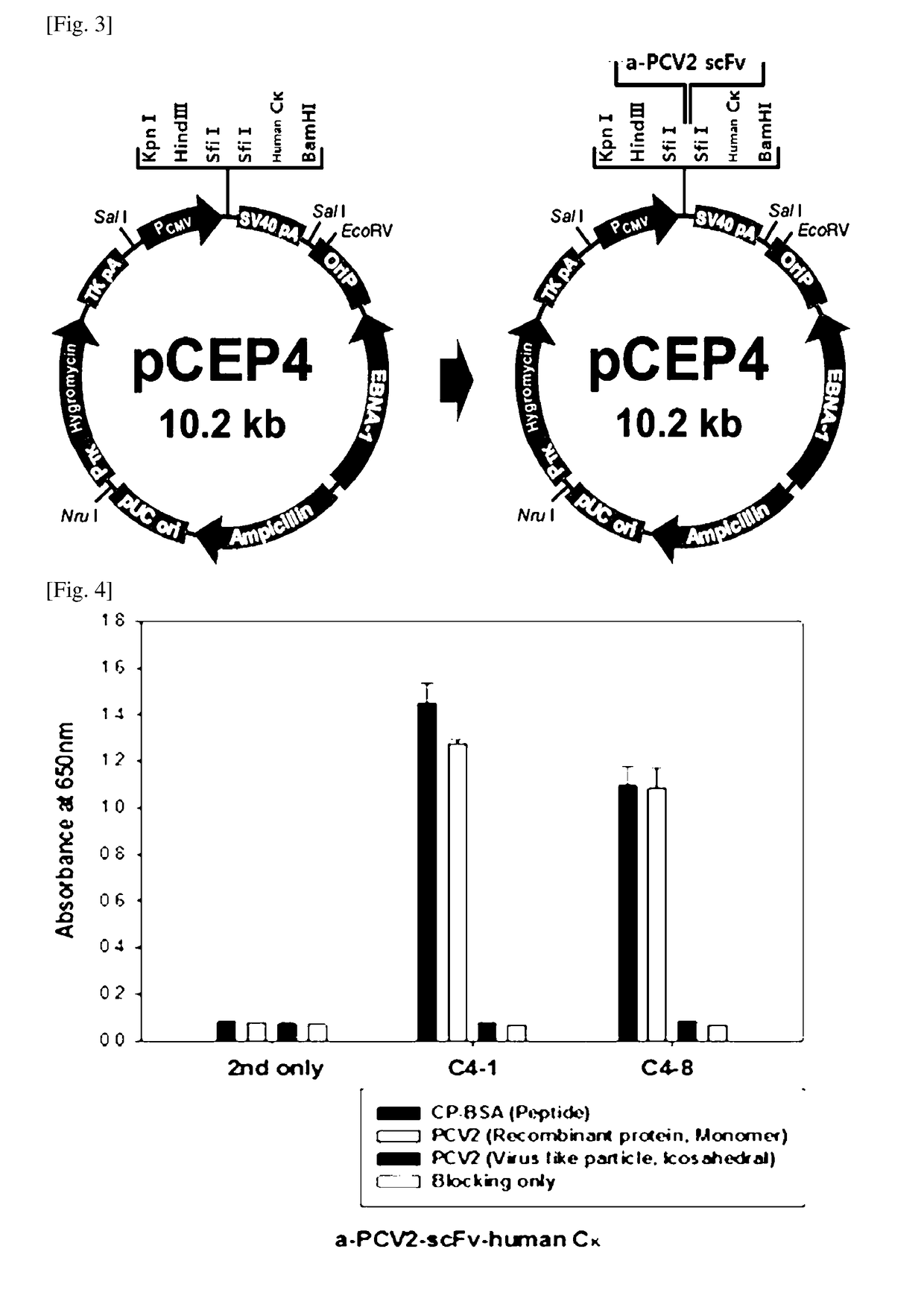Monoclonal antibody specific to pcv2 and method for diagnosing pmws using same
a technology of pcv2 and monoclonal antibody, which is applied in the field of monoclonal antibody specific to pcv2 and the method of diagnosing pmws using same, can solve the problem of difficult to accurately diagnose pcv2 simply
- Summary
- Abstract
- Description
- Claims
- Application Information
AI Technical Summary
Benefits of technology
Problems solved by technology
Method used
Image
Examples
example 1
on of PCV2 Antigen
[0078]1-1. Synthesis of Peptides
[0079]Cysteine was added to the end of the 12 amino acids positioned from the 169th to the 180th, which was known as a decoy epitope of porcine circovirus 2 (PCV2), to synthesize a peptide (Peptron, Korea). BSA and KLH were conjugated to the cysteine of the C-terminus and used it as an antigen for screening antibody and the immunity of chickens. The STIDYFQPMMKR peptide was named as CP-BSA or CP-KLH, short for the circovirus peptide.
[0080]1-2. PCV2 Recombinant Protein (Monomer)
[0081]The amino acids at the N-terminus of PCV2 were deleted not to generate an icosahedral structure but to be present in a monomeric form to expose the CP (169 to 180) decoy epitope, thereby enabling a recombinant protein expressed in E. coli to include the amino acid residues of the CP of PCV2 from the 43rd to the 233rd (FIG. 1). The recombinant protein was expressed in E. coli using the method known in the art [see (Pileri E et al., Vet J. 2014, 201(3), 429...
example 2
on of Library of Immune Antibody Against PCV2
[0085]2-1. Immunization
[0086]The peptide KLH conjugate (CP-KLH; 50 μg) synthesized in Example 1, as an antigen, was mixed with phosphate buffered saline (PBS; 750 μL) and cultured at 37° C. for 30 minutes. Then, the resultant was emulsified in an adjuvant of water-in-oil emulsion (RIBI+MPL+TDM+CWS adjuvant, Sigma, St. Louis, Mo., USA) containing detoxified endotoxin (monophosphorylate lipid A species; MPL) and mycobacterial cell wall components (TDW, CWS) in 2% squalene, and then subcutaneously injected to 3 chickens. In the same manner, the chickens were further inoculated 3 weeks thereafter, and subsequently 2 weeks thereafter thereby performing a total of 3 immunizations. The antibody titer of the immunized chickens was determined by an enzyme-linked immunosorbent assay (ELISA) using the horseradish peroxidase (HRP) conjugated anti-chicken IgG (Y) polyclonal antibody (rabbit anti-chicken IgG(Y)-HRP, Millipore corporation, Billeria, Mas...
example 3
anning on Fixed Antigen (Bio-Panning)
[0096]Bio-panning was performed using magnetic beads (Dynabeads M-270 Epoxy, Invitrogen). An antigen was coated while rotating / stirring 3 μg of CP-BSA (peptide) and PCV2 recombinant protein (monomer) to the 1×107 beads at room temperature for 20 hours. The coated beads were washed 4 times with PBS, blocked with PBS containing 3% BSA at room temperature for 1 hour, and cultured with the phage-displayed scFv obtained from Example 2-3 at room temperature for 2 hours. To remove the phage, which is not bound to the antigen coated to the beads, the beads were washed with 0.05% Tween 20 / PBS, and the bound phage was eluted using 50 μL of 0.1 M glycine-HCl (pH 2.2) and neutralized with 2 M Tris-HCl (pH 9.1). E. coli ER2738 was infected using the phage-containing supernatant and, for the overnight amplification of phage, was rescued using VCSM13 helper phage. Additionally, the culture broth infected with the phage was plated on an LB agar plate containing ...
PUM
| Property | Measurement | Unit |
|---|---|---|
| volume | aaaaa | aaaaa |
| volume | aaaaa | aaaaa |
| volume | aaaaa | aaaaa |
Abstract
Description
Claims
Application Information
 Login to View More
Login to View More - R&D
- Intellectual Property
- Life Sciences
- Materials
- Tech Scout
- Unparalleled Data Quality
- Higher Quality Content
- 60% Fewer Hallucinations
Browse by: Latest US Patents, China's latest patents, Technical Efficacy Thesaurus, Application Domain, Technology Topic, Popular Technical Reports.
© 2025 PatSnap. All rights reserved.Legal|Privacy policy|Modern Slavery Act Transparency Statement|Sitemap|About US| Contact US: help@patsnap.com



